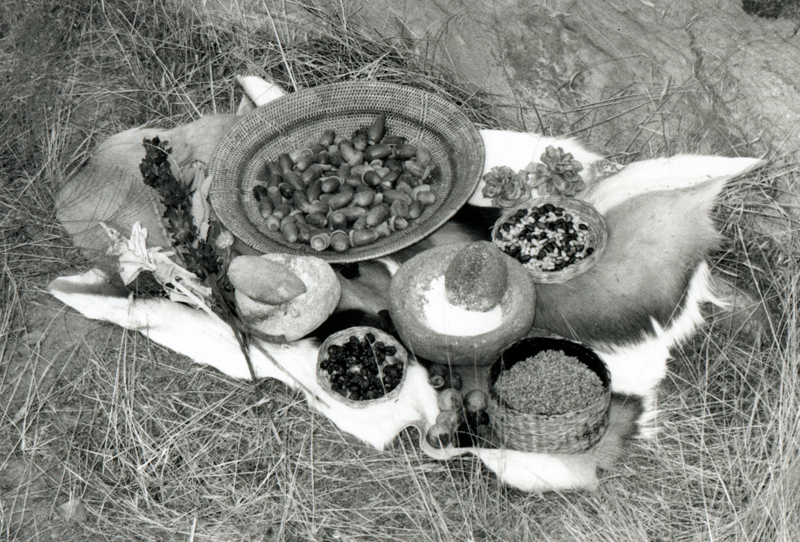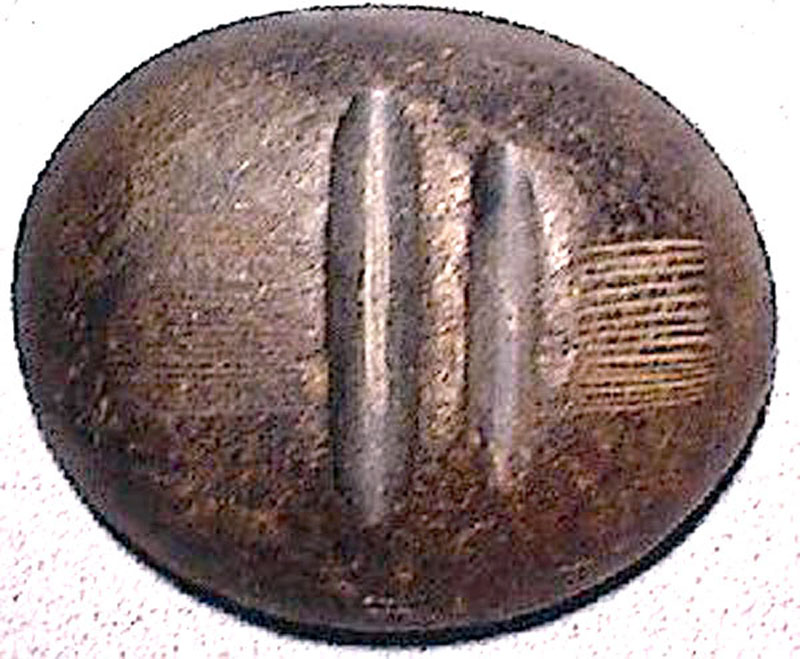|
|
Vasquez Rocks County Park

Click image to enlarge
Example of what a Tataviam Indian kitchen setting might have looked like. The Tataviam Indians were a Shoshone-speaking people who arrived in the Upper Santa Clara River Valley (Santa Clarita Valley) about AD 450. They occupied an area bounded by Piru to the west, Newhall to the south, the Liebre Mountains to the north, and Soledad Pass to the east. The word tataviam roughly translates into "People of the Sunny Slopes." Their Kitanemuk neighbors in the Antelope Valley called them "Aliklik," believed to be a derogatory term for the clicking sound of their language. While it is not known exactly who preceded the Tataviam, the same area was occupied by a people, probably of Chumash origin, who arrived somewhere between 4,000 and 10,000 years ago. The Tataviam were hunter-gatherers who organized into a series of autonomous tribelets throughout the region. They ate acorns, yucca, juniper berries, sage seeds and islay, and they hunted small game. They likely practiced a shamanist religion that put them in touch with the supernatural world through trances and hallucinations brought on by the ingestion of jimsonweed, native tobacco and other psychoto-mimetic plants found along the local rivers and streams. Such habitats also provided raw materials for baskets, cordage and netting. The arrival of Spanish settlers in 1769 led to the demise of the Tataviam people. The Spanish rounded up the aborigines in the early 1800s and conscripted them for manual labor at the mission ranches and vineyards, where they intermarried with other native folk from other parts of Southern California. The last full-blooded Tataviam, Juan José Fustero, died on June 30, 1921, at Rancho Camulos, near Piru.* * NOTE: While Fustero liked to bill himself as the "Last of the Piru Indians," an article in the Los Angeles Herald Examiner in 1965 says that Fustero may actually been married to a full-blooded Tataviam woman, and that they had children. Furthermore, according to "Standing Bear" Rudy Ortega Jr., Spiritual Leader of the Tataviam-Fernandino Tribe, as of 1997 there were approximately 600 persons of Tataviam descent living in Los Angeles County. Kitchen setting designed by Paul Higgins. For more on this subject, read The Tataviam: Early Newhall Residents by Paul Higgins.
LW9554: 19200 dpi jpeg from 4x6 print made from film shot by Leon Worden circa 1995. |
Bowers Cave Specimens (Mult.)
Bowers on Bowers Cave 1885
Stephen Bowers Bio
Bowers Cave: Perforated Stones (Henshaw 1887)
Bowers Cave: Van Valkenburgh 1952
• Bowers Cave Inventory (Elsasser & Heizer 1963)
Tony Newhall 1984
• Chiquita Landfill Expansion DEIR 2014: Bowers Cave Discussion
Vasquez Rock Art x8
Ethnobotany of Vasquez, Placerita (Brewer 2014)
Bowl x5
Basketry Fragment
Blum Ranch (Mult.)
Little Rock Creek
Grinding Stone, Chaguayanga
Fish Canyon Bedrock Mortars & Cupules x3
2 Steatite Bowls, Hydraulic Research 1968
Steatite Cup, 1970 Elderberry Canyon Dig x5
Ceremonial Bar, 1970 Elderberry Canyon Dig x4
Projectile Points (4), 1970 Elderberry Canyon Dig
Paradise Ranch Earth Oven
Twined Water Bottle x14
Twined Basketry Fragment
Grinding Stones, Camulos
Arrow Straightener
Pestle
Basketry x2
Coiled Basket 1875
Riverpark, aka River Village (Mult.)
Riverpark Artifact Conveyance
Tesoro (San Francisquito) Bedrock Mortar
Mojave Desert: Burham Canyon Pictographs
Leona Valley Site (Disturbed 2001)
2 Baskets
So. Cal. Basket
Biface, Haskell Canyon
2 Mortars, 2 Pestles, Bouquet Canyon
|
The site owner makes no assertions as to ownership of any original copyrights to digitized images. However, these images are intended for Personal or Research use only. Any other kind of use, including but not limited to commercial or scholarly publication in any medium or format, public exhibition, or use online or in a web site, may be subject to additional restrictions including but not limited to the copyrights held by parties other than the site owner. USERS ARE SOLELY RESPONSIBLE for determining the existence of such rights and for obtaining any permissions and/or paying associated fees necessary for the proposed use.


































